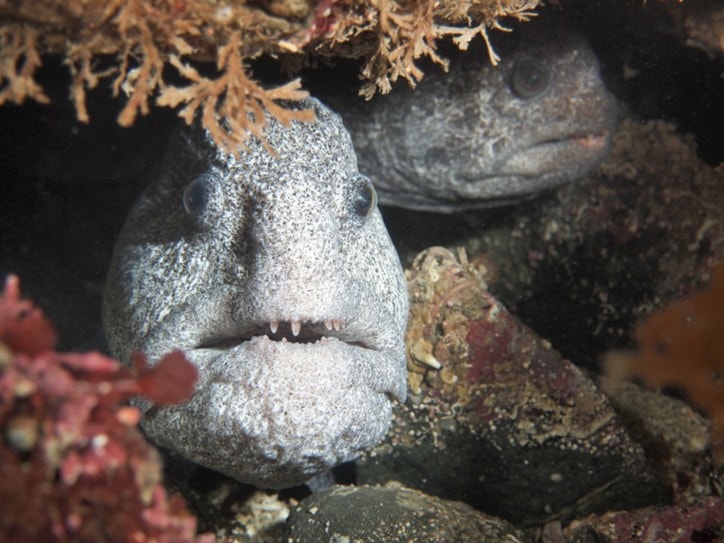Don't say it, please don't say it.
This is not an ugly fish.
It hurts when people say this about wolf-eels. Such is the way when there is misunderstanding and disrespect for something you love.
There is no ugly in Nature - only perfection.
If the features of an animal appear foreign to you, it is because it fulfils a role in Nature that is truly awe-inspiring; possibly even beyond your imaginings.
I hope to make this point by sharing with you why the wolf-eel is "designed" as it is and how very wrong many of us are in our perceptions about this species.
The wolf-eel (Anarrhichythys ocellatus), which can be as long as 2.4 metres, is not an eel. It is clearly also not a wolf. It is desperately misunderstood.
It is not dangerous nor "mean". The opposite is true. They are reclusive, anything but ferocious, quite sedentary and slow moving.
Yes, the mature males have very large, fleshy, ossified heads and the species has sharp teeth but this is so they can do what so few marine species can — they can feed on spiny sea urchins, snapping them effortlessly into pieces without suffering a single puncture. They also feed on other hard-shelled animals like shellfish and crabs.
Even the roofs of wolf-eels' mouths are impenetrable with ossified, tooth-like projections.
To my knowledge there has never been an attack on a diver UNLESS, and here comes the predictable thing, we choose to habituate them.
Wolf eels spend a great deal of time on the ocean bottom in dens where, as divers, we have the enormous privilege of visiting the same spot and seeing the same individuals for years. It is not just their address that makes they recognizable as individuals. Each wolf-eel has a unique pattern of black spots near its eyes.
Some divers choose to feed them, leading to the wolf-eels associating us with food. That's where accidents can happen and where the wild behaviour that lets animals survive, becomes compromised.
It also makes them tragically easy targets for any spear diver wanting to poach them. There is no legal fishery for this species but there is a demand for them in the Asian market, which is why there are also attempts to farm wolf-fish i.e. aquaculture.
Not surprisingly, wolf eels might also be defensive when accidentally caught by anglers. I found one account from 1959 where a commercial fisherman was bitten and "The teeth penetrated the hip-waders and broke the skin on both sides of the ankle."
The mature males do carry battle wounds supporting the idea they don't just hang out in dens waiting for a snack to come by, but rather that they will occasionally duke it out with other male wolf-eels. They do also sometimes need to do battle for den space with a giant Pacific octopus. This is likely another driver for the male's having such fleshy heads — they are better able to survive the wounds inflicted by such battles.
Another unique feature about this species is their eel-like body. They are the only member of their family that have this body shape. The long tail serves in locomotion, powering them forward with big, slow, s-shaped waves while being stabilized with the long dorsal and pectoral fins (see video below). Having a long tail also allows them to den-up, curling up and around in narrow spaces between rocks and . . . wait for it . . . it lets them hold onto their eggs.
Wolf eels have long-lasting pair bonds, coming together when they are around four years old and having their first clutch when they are around seven. In aquariums, their life expectancy is known to be at least 28 years.
Both male and female juveniles are brownish orange and look even more eel-like, lacking the big head of the adults. As adults, the females are smaller and a darker brownish grey (both remarkably camouflaged for when they are in their rocky dens).
Mating apparently most often occurs between October and December, with the female releasing eggs after the male prods against her swollen abdomen. He then wraps around her to fertilize the 10,000 or more white to yellow eggs that she will mould into a ball shape. This mass does not need to adhere to anything because the parents will take turns wrapping their tails around the mass, holding and turning it for good aeration until the +/- 3.5 cm young hatch some three months after fertilization.
The juveniles do not settle into the adult sedentary lifestyle until around age two. One juvenile is even known to have travelled a minimum of 1,000 km; having been tagged in Port Hardy, B.C., and found back in Willapa Bay, Washington two years later.
It was long thought that wolf-eels always mate for life but, this is not always the case. The males do compete for females who will sometimes opt to swap dens and go live with the competitor. Sound like any other species you know? Wonder if it happens at mid-life?
The wolf eel is indeed akin to us in so many ways. It is a homebody that likes crunchy snacks and prefers that they come right by the front door; they are great parents and are docile unless fighting for home or partner. They invest in durable relationships and they are only as strange looking as we terrestrial bipeds would appear to them.
Jackie Hildering is a biologist, avid scuba diver, and marine educator who lives in Port McNeill. For more fish love, see www.themarinedetective.ca.
